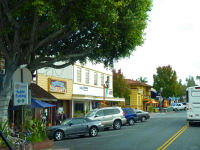“What you do speaks so loudly that I cannot hear what you say.”
Ralph Waldo Emerson
By Walter Hall
November 2, 2011 (La Mesa)--This is the final installment of ECM’s three- part series on the proposed Property-based Business Improvement District (PBID) for downtown La Mesa. As the process enters the voting stage, we review the changing expectations and remaining concerns among business and property owners in the district. For the background and readers’ comments see Part I http://www.eastcountymagazine.org/node/6980; the most contentious issues in the story are examined in Part II at http://www.eastcountymagazine.org/node/7105
“...All over but the voting” was the lead sentence in La Mesa Today’s recent report on the PBID Formation
 Committee’s ten-month effort. If only.
Committee’s ten-month effort. If only.It’s certainly true that the Committee has successfully teed up the PBID petition that will be mailed to all property owners in the proposed district in coming weeks. If sufficient petitions are returned to approve a formal ballot, the voting will occur – sometime in early 2012. But even if the balloting sets the PBID in motion, it will face a steep uphill road, with plenty of washboard.
A review of current thinking in the district tells us why.
In the two months since Part I of this series appeared, attitudes among business owners and professionals in the district appear to have changed very little – or not at all. The PBID opposition is still nursing and rehashing last year’s grievances, bogged down in threats, rather than specific counter-proposals.
PBID advocates are sticking to their original story. City leaders and Formation Committee members who walk the downtown area and listen to the boosters could be forgiven for thinking that the PBID is whistling down the right track.
Further afield, enthusiasm is flagging. West of Date Street there is little interest in the subject. Many feel an initiative like the PBID should have been undertaken years ago. Not now. People are feeling tapped out and nervous. The PBID seems a day late and a dollar short.
Neither advocates nor critics have bothered to enrich their arguments by drawing upon the experience of other revitalization projects around the country. That prompts the first question.
Question. Has the thinking on the PBID changed since the first public meeting in January this year?
Answer: Not much. Opinions formed during the roll-out last January have not evolved and for all the brickbats since thrown, precious little effort has been expended to refine them – either way.
The large protest banner that flew over the east end of the Boulevard during Oktoberfest notwithstanding, most people in the district appear either exhausted by the subject or indifferent. They are not following the Formation Committee process and they are not particularly concerned about it.
Critics – and people who should know better - still will not do the work or have not invested the time to learn enough to advance their standpoint. Instead, they peddle political buzzwords (government expansion, tax increases, and bloated administration expense) breezily unaware that such threadbare shibboleths do not apply to what is a conventional private sector redevelopment mechanism.
Nor is there much evidence that those most directly interested in the success of the PBID are digging into the voluminous and accessible literature on the subject. Little wonder then that others, at further remove, now find the subject tiresome.
That may change soon. The PBID Formation Committee just spun off an Action Committee. The new group is building an information-rich website to combat misinformation. When released, it will be found at www.downtownlamesa.org.
One such bit of misinformation is that the PBID will be run by the City of La Mesa. Not true. The proposed PBID will be governed by a Board of Directors consisting of property and business owners in the district who will retain professional staff to do the organization’s work.
As people learn how a PBID will actually work – that it is not in fact a way for the City to dodge existing maintenance obligations – thinking along the Boulevard will continue to shift. A solid information (not publicity) campaign is long overdue.
Question: What have we learned since January?
Answer: Again, surprisingly, not much. This is certainly not a criticism of the work of the Formation Committee. In over 20 meetings and countless informal exchanges, they hammered out a blueprint. But neither the Committee, nor the City, nor any other redevelopment enthusiast yet offers an unassailable case statement for the PBID, explaining why it should be launched at this time.
Political scientist and public administration expert James Q. Wilson once admonished would be policymakers that “it is a good idea to know more about proposed or enacted policies than can be inferred from an ideology or extracted from journalism.” Do we “know” that the PBID is the right instrument for moving downtown forward at this time?
The American experience with urban redevelopment, in various settings, suggests caution. Jane Jacobs’ work on urban renewal, described in her Death and Life of Great American Cities, points up the importance of retaining the coherence and vitality of old neighborhoods. Nathan Glazer’s seminal work, The Limits of Social Policy goes further, arguing that “the creation and building of new traditions, or new versions of old traditions, must be taken more seriously as a requirement of social policy itself.”
These are not arguments for doing nothing. Late in his career, Glazer reflected that “[When] I look at policies that are trying to improve welfare, I think you must keep on trying even if you have not had great success.” So, it is important to act, but only after some forethought.
Craig Maxwell’s pensive column in the La Mesa Patch (“It Takes a Genuine Community,” Sept. 2010) tapped into conservative “let’s not just burn down the house” reasoning well before the PBID flak began to fly. But what is the “right” mix for renewal? What amount of funded activity will permit a credible showing, yet not overreach, draining both goodwill and the well?
The PBID Formation Committee invested much time and thought on this. But have they got it right? By what measure would we know that? How did they arrive at their judgments? Can we assume that they at least read “Is a BID Feasible in Your Town?” in the National Trust monthly Mainstreet News and then answered most of the ten pre-launch criteria in the affirmative?
People are crossing their fingers in the hope that the PBID is the result of a deliberate, broadly-informed review and decision process, not simply a late-game Hail Mary.
Interestingly enough, those who see downtown renovation as a threat to the Village’s retro look do not marshal available sources to make their case either. The National Council for Public History and the American Association for State and Local History offer abundant material to defend local heritage, but they make no appearance here, despite the palpable fears that La Mesa’s eclectic inheritance will be designed into oblivion.
Question: Are PBID expectations converging?
Answer: Yes, but... Today, strong views range as widely as they did last January. If the balloting produces a green light, the PBID will become the unwilling recipient of a trunk full of civic baggage. Think of a wedding reception where one of the two families sits blinking in disbelief.
What will happen? No one knows. This is uncharted ground for La Mesa. Some see hardship, but few forecast ruin. Mercifully, the downtown question is not governed by absolutes. As several thoughtful citizens have observed, it is not “Gaslamp or die.”
Concerns that the PBID budget is too ambitious are connected to fears that funds collected for PBID budgets will only encourage irresponsible behavior – and/or the continued failure to adequately address painful fiscal questions, such as pension funding shortfalls – by the City Council and administration.
Harsher critics point out that La Mesa businesses have tightened belts and taken reduced pay to survive lean times. “And the City?” they ask. Some are incredulous that the City can’t find $300,000 to perform what are essential civic functions (security, maintenance and promotion).
Fortunately, La Mesa suffers only a pale echo of the blind negativity that drives our national paralysis. Yet, some anti-PBID partisans see no margin in compromise. For them, nothing good can happen during this administration’s tenure in City Hall. Period. They will criticize, oppose and obstruct everything – no matter the merits. There is no serious effort to understand, because there is no intention to participate. Their sole purpose is to ensure that city leaders get as little credit, and as much criticism, as possible.
Against that stream, the volunteers on the PBID Formation Committee have patiently rowed. They’ve done the work, crunched the numbers, trimmed the scope, and balanced competing objectives. And now there are signs that the current is turning in their favor.
Many once uncommitted business owners now say that the current PBID design is sufficiently timid to meet any prudent requirement for caution. Former skeptics see the annual assessments as a small price for an updated downtown that attracts new visitors and shoppers. The fog of disinformation about a backdoor tax increase with zero benefits is gradually being discredited.
PBID advocates ask us to imagine the combined effect of the planned Streetscape improvements, the Village Merchants Association’s signature events and various Chamber of Commerce activities, with PBID-funded promotion, maintenance and hospitality services. The enabling impact of a predictable and non-voluntary funding stream would be significant. It’s not hard to see the point.
When queried, many La Mesans (on the Boulevard and in the hills) agree. The Village would benefit from a facelift and better overall marketing, in addition to current event-specific efforts. But they are unsure just how a PBID would get those things done. So much depends on execution. And long memories keep trust levels low.
So we return to a question Mr. Maxwell posed last September while writing of the town’s unique architectural and social make-up. “But what will we do with it?” he asked. Petitions and ballots will settle the PBID’s future, but that vexing question will still hang over the Village. Once everyone’s had a say, what will we do?
This concludes the series, but it hardly closes the subject. La Mesa sits astride the main arteries between San Diego and East County. The outcome here matters. Join the conversation, check out that new website and share your thoughts with the community. Everyone in La Mesa has a stake in this.














Recent comments